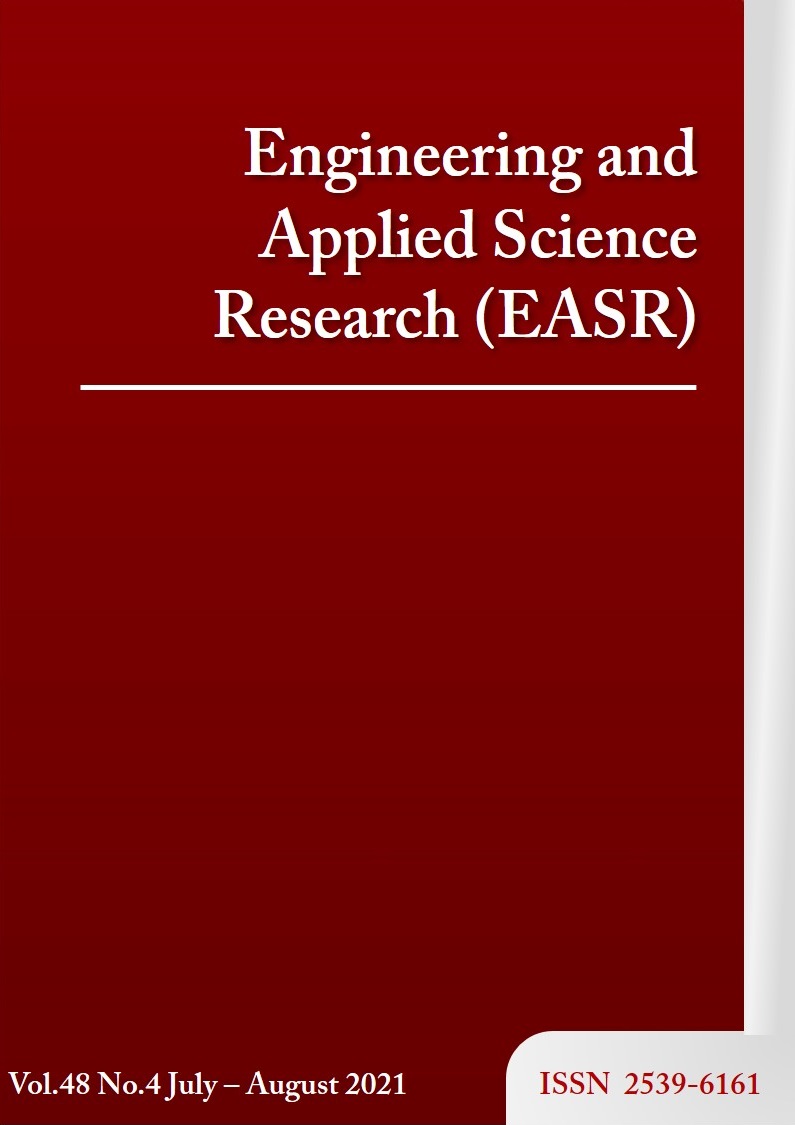Creep behaviors of ASTM A36 welded joints
Main Article Content
Abstract
This research work aimed to observe the creep behaviors of the ASTM A36 welded joints. The microstructure and hardness of the base zone (BZ), heat affected zone (HAZ), and weld fusion zone (WFZ) were measured. Afterward, the residual stresses on the welded plate were observed to determine any lead to fatigue failure. The hot tensile tests were then performed to investigate the welded specimens' creep behaviors at varied strain rates and temperatures. The power-law model was applied to describe the creep behaviors at each testing condition. Finally, the scanning electron microscopic (SEM) images of the tested specimens were observed to identify breakage causes. The creep results showed that the weakest locations were found in the base (A36) zones. The areas prone to ductile fracture was the base zones close to HAZ.
Article Details
This work is licensed under a Creative Commons Attribution-NonCommercial-NoDerivatives 4.0 International License.
References
Fabricius A, Jackson PS. Premature grade 91 failures-worldwide plant operational experiences. Eng Fail Anal. 2016;66:398-406.
Kassner ME. Fundamentals of creep in metals and alloys. 3rd ed. UK: Butterworth-Heinemann; 2015.
Nabarro FRN, Villiers Fd. Physics of creep and creep-resistant alloys. US: CRC Press; 2018.
Creep-Resistant steels. Woodhead publishing series in metals and surface engineering. USA: Woodhead Publishing; 2008.
Abe F. Progress in creep-resistant steels for high efficiency coal-fired power plants. J Pres Ves Tech. 2016;138(4).
Madyira DM, Liebenberg JA, Kaymacki A. Comparative characterization of P91 and 10crmo9-10 creep resistant steel welds. Procedia Manuf. 2017;8:345-52.
Pandey C, Mahapatra MM, Kumar P. Effect of post weld heat treatments on fracture frontier and type IV cracking nature of the crept P91 welded sample. Mater Sci Eng. 2018;731:249-65.
Pandey C, Mahapatra MM, Kumar P, Kumar S, Sirohi S. Effect of post weld heat treatments on microstructure evolution and type IV cracking behavior of the P91 steel welds joint. J Mater Process Tech. 2019;266:140-54.
Pandey C, Mahapatra MM, Kumar P, Vidyrathy RS, Srivastava A. Microstructure-based assessment of creep rupture behavior of cast-forged P91 steel. Mater Sci Eng. 2017;695:291-301.
Pandey C, Mahapatra MM, Kumar P, Saini N. Some studies on P91 steel and their weldments. J Alloy Comp. 2018;743:332-64.
Jovicic R, Sedmak S, Cvetkovic RP, Popovic O, Bubalo KJ, Milosevic N. Effects of welding technology on the occurrence of fracture in welded joints. Procedia Struct Integrity. 2018;13:1682-8.
Zhao L, Jing H, Xu L, Han Y, Xiu J. Experimental study on creep damage evolution process of Type IV cracking in 9Cr-0.5Mo-1.8W-VNb steel welded joint. Eng Fail Anal. 2012;19:22-31.
Sakthivel T, Laha K, Chandravathi KS, Parameswaran P, Tailor HM, Vasudevan M, et al. Integrity assessment of grade 92 welded joint under creep condition. Procedia Eng. 2014;86:215-22.
Wei Y, Qiao S, Lu F, Liu W. Failure transition mechanism in creep rupture of modified casting 9Cr-1.5Mo-1Co welded joint. Mater Des. 2016;97:268-78.
Liu W, Lu F, Wei Y, Ding Y, Wang P, Tang X. Special zone in multi-layer and multi-pass welded metal and its role in the creep behavior of 9Cr1Mo welded joint. Mater Des. 2016;108:195-206.
El-Desoky OE, Abd El-Azim ME, ElKossy MR. Analysis of creep behavior of welded joints of P91 steel at 600 °C. Int J Pres Ves Pip. 2019;171:145-52.
Chaurasia PK, Pandey C, Giri A, Saini N, Mahapatra MM. A comparative study of residual stress and mechanical properties for FSW and TIG weld on structural steel. Arch Metall Mater. 2018;63(2):1019-29.
Taraphdar PK, Thakare JG, Pandey C, Mahapatra MM. Novel residual stress measurement technique to evaluate through thickness residual stress fields. Mater Lett. 2020;277:128347.
Taraphdar PK, Pandey C, Mahapatra MM. Finite element investigation of IGSCC-prone zone in AISI 304L multipass groove welds. Arch Civ Mech Eng. 2020;20(2):54.
Josef B. Creep Mechanics. 3rd ed. Berlin: Springer; 2008.
Rusinko A, Rusinko K. Plasticity and creep of metals. Berlin: Springer; 2011.
Zhao L, Jing H, Xu L, An J, Xiao G. Numerical investigation of factors affecting creep damage accumulation in ASME P92 steel welded joint. Mater Des. 2012;34:566-75.
Prokhorov A, Kostina A, Vedernikova A, Plekhov O, Menaka M, Venkatraman B. Experimental and numerical investigation of the fracture in steel welded joints. Procedia Struct Integrity. 2018;13:1521-6.
Lagoda T. Lifetime estimation of welded joints. Berlin: Springer; 2011.
Besson J, Leclercq S, Gaffard V, Gourgues-Lorenzon AF. Analysis of creep lifetime of an ASME Grade 91 welded pipe. Eng Fract Mech. 2009;76(10):1460-73.
Jelwan J, Chowdhury M, Pearce G. Design for creep: a critical examination of some methods. Eng Fail Anal. 2013;27:350-72.
Wang X, Wang X, Luo B, Guo J. Analysis of cavity evolution in 9%Cr heat-resistant steel welded joint during creep. Eng Fract Mech. 2018;202:394-404.
Zhang W, Wang X, Wang Y, Yu X, Gao Y, Feng Z. Type IV failure in weldment of creep resistant ferritic alloys: II. Creep fracture and lifetime prediction. J Mech Phys Solid. 2020;134:103775.
Kelly FS, Sha W. A comparison of the mechanical properties of fire-resistant and S275 structural steels. J Constructional Steel Res. 1999;50(3):223-33.
Zhu ML, Xuan FZ. Effect of microstructure on strain hardening and strength distributions along a Cr-Ni-Mo-V steel welded joint. Mater Des. 2015;65;707-15.
Pandey C, Mahapatra MM. Effect of groove design and post-weld heat treatment on microstructure and mechanical properties of p91 steel weld. J Mater Eng Perform. 2016;25(7):2761-75.
Pandey C. Mechanical and metallurgical characterization of dissimilar p92/ss304 l welded joints under varying heat treatment regimes. Metall Mater Trans. 2020;51(5):2126-42.
Pandey C, Mahapatra MM, Kumar P, Saini N. Effect of creep phenomena on room-temperature tensile properties of cast & forged P91 steel. Eng Fail Anal. 2017;79:385-96.
Pandey C, Mahapatra MM, Kumar P, Sirohi S. Fracture behavior of crept P91 welded sample for different post weld heat treatments condition. Eng Fail Anal. 2019;95:18-29.



